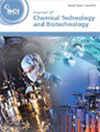Facile Design of Continuous Periodic Countercurrent, dual-flow, and capture SMB adsorptive processes
Abstract
BACKGROUND
Chromatographic capture is a critical step in the manufacture of protein-based therapeutics and often dominates the overall downstream processing cost. Multicolumn systems as well as systems where the load flow rate varies over time can be employed to improve productivity and reduce the consumption of buffers and other process chemicals by enhancing utilization of the binding capacity. This work addresses the design of such systems under mass transfer control conditions using a mechanistic model.
RESULTS
Generalized, dimensionless charts and interpolating functions developed based on a mechanistic model are provided to predict the operating conditions and performance attributes of periodic countercurrent, dual-flow, and Capture SMB systems for continuous capture with adsorption columns. The underlying model is based on the Langmuir isotherm and on the assumption that mass transfer is controlling. The results cover the ranges typically encountered in the capture of biopharmaceuticals with selective adsorbent particles and can be conveniently used for practical estimations without having to resort to the numerical solution of the model equations. Illustrative examples are provided and compare favorably with previously published results.
CONCLUSIONS
The results of this work provide the means to rapidly design periodic countercurrent, dual-flow capture systems, and capture SMB units and to assess their relative advantages under varying operating conditions circumventing the need to perform computationally intensive simulations. © 2024 The Author(s). Journal of Chemical Technology and Biotechnology published by John Wiley & Sons Ltd on behalf of Society of Chemical Industry (SCI).

 求助内容:
求助内容: 应助结果提醒方式:
应助结果提醒方式:


